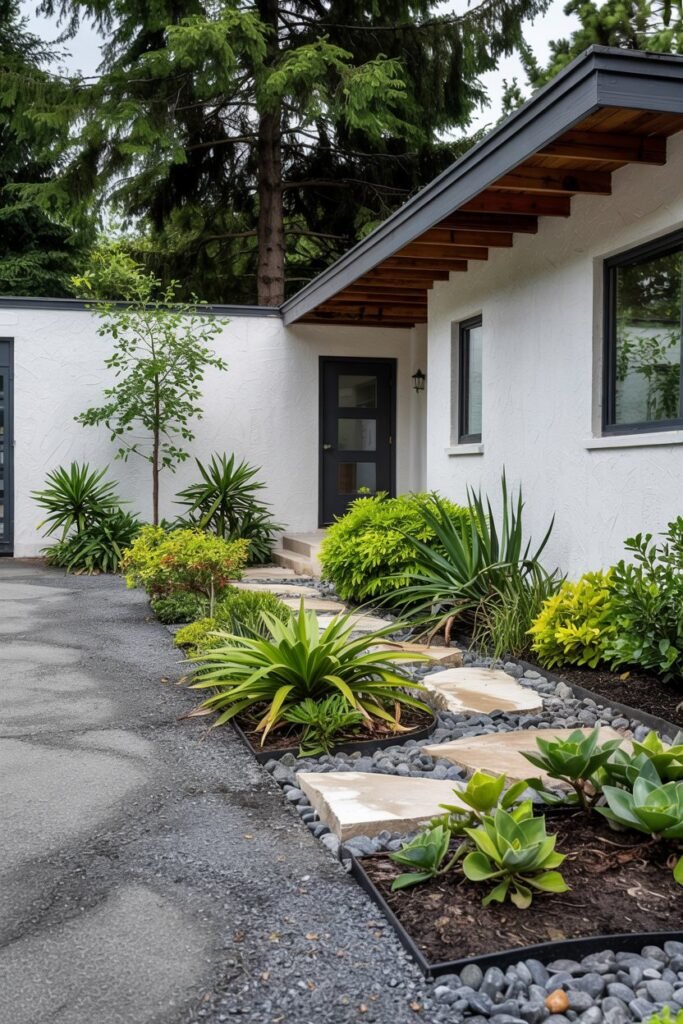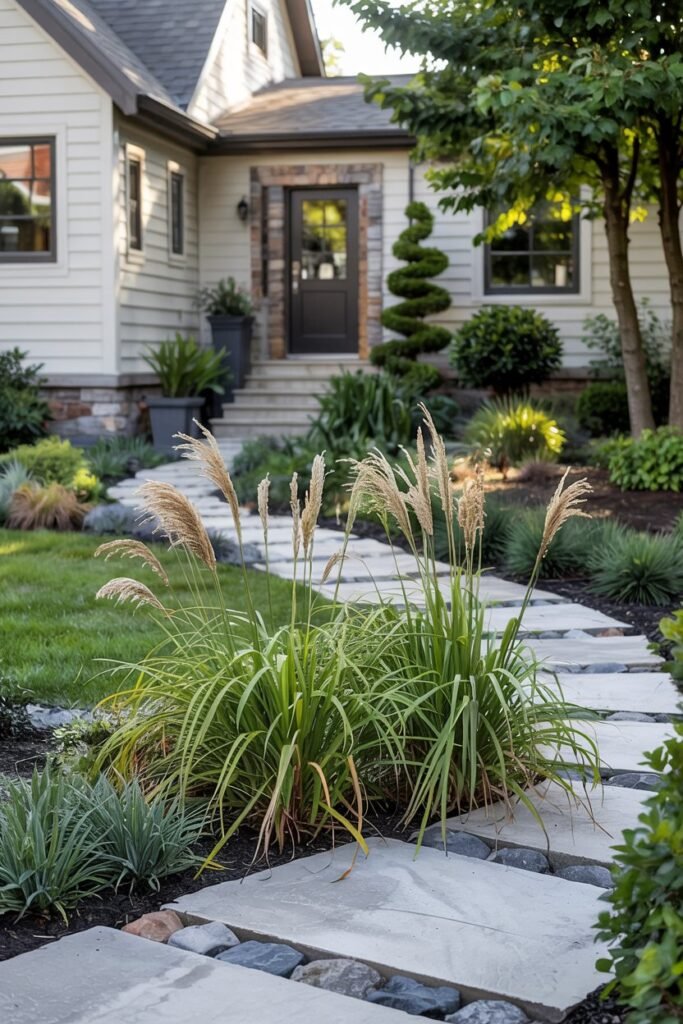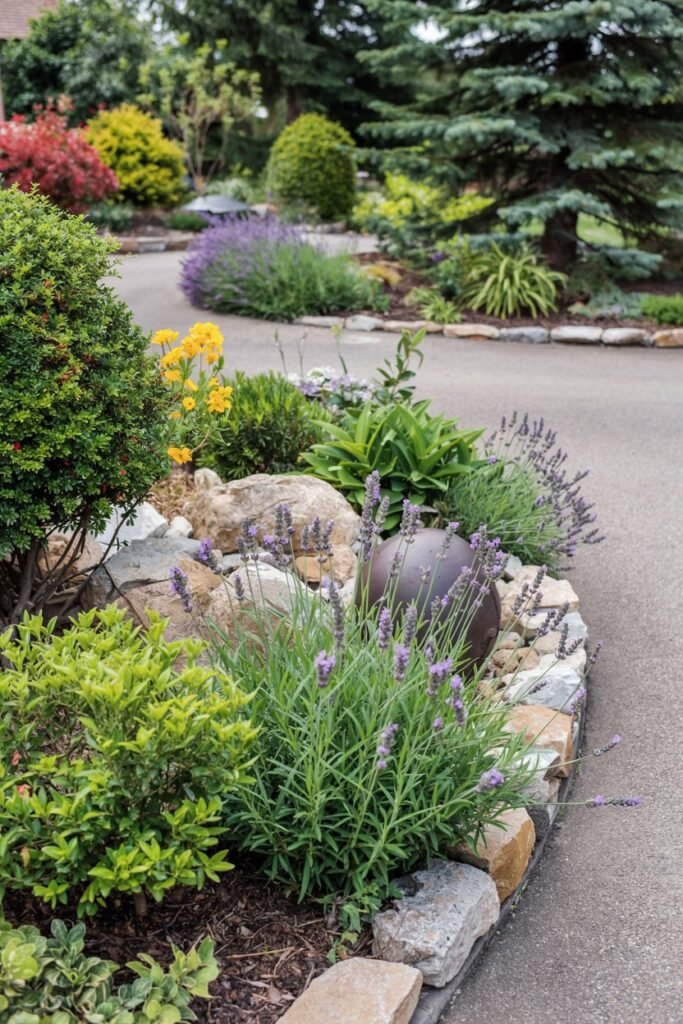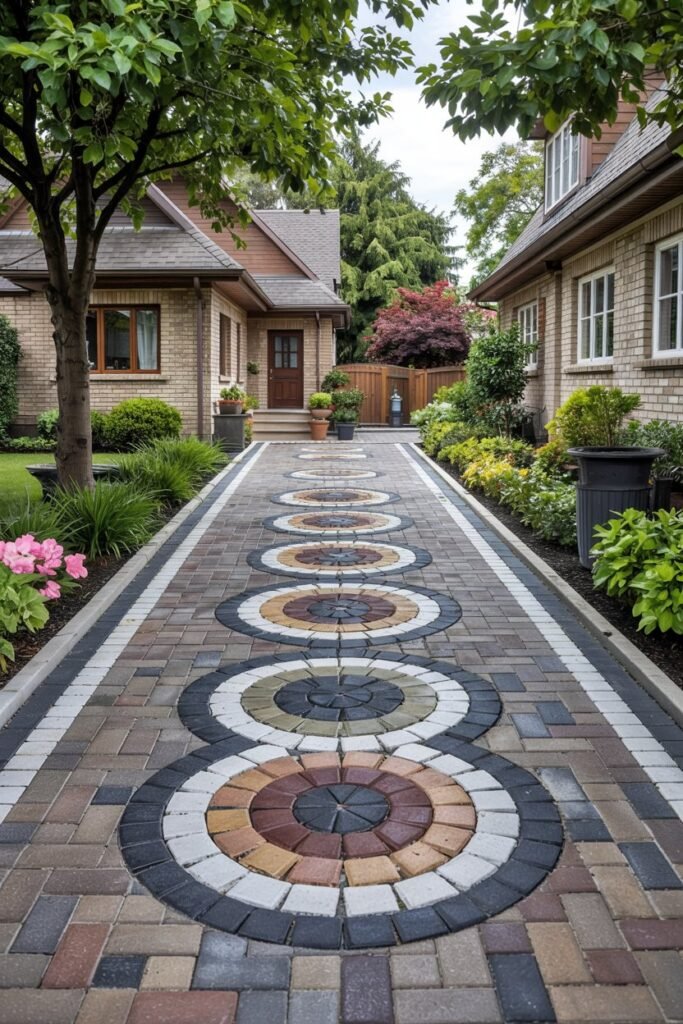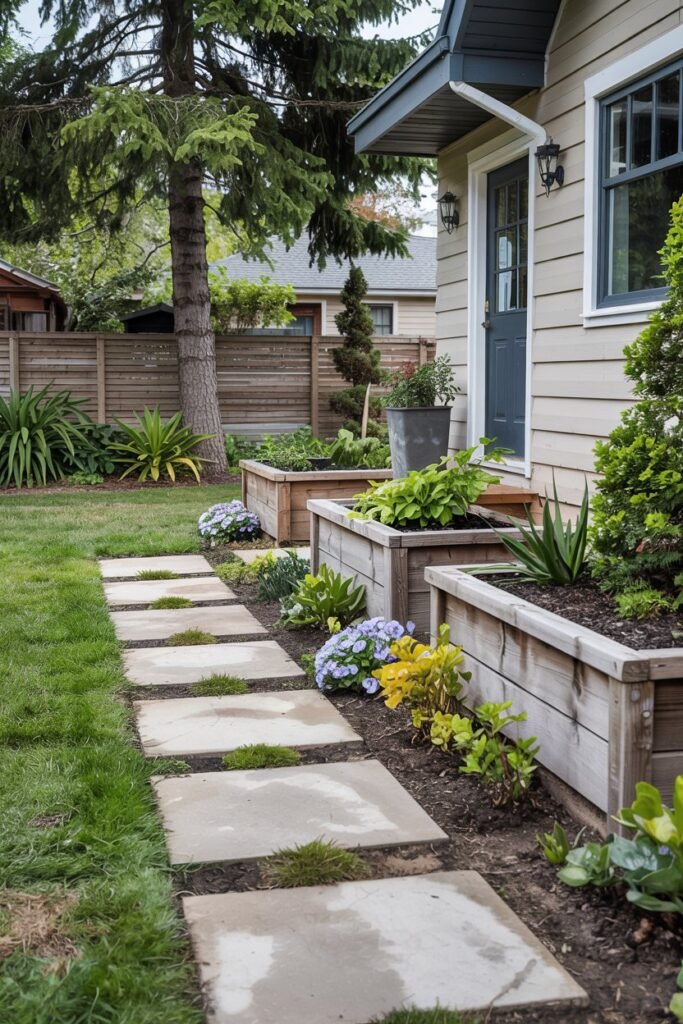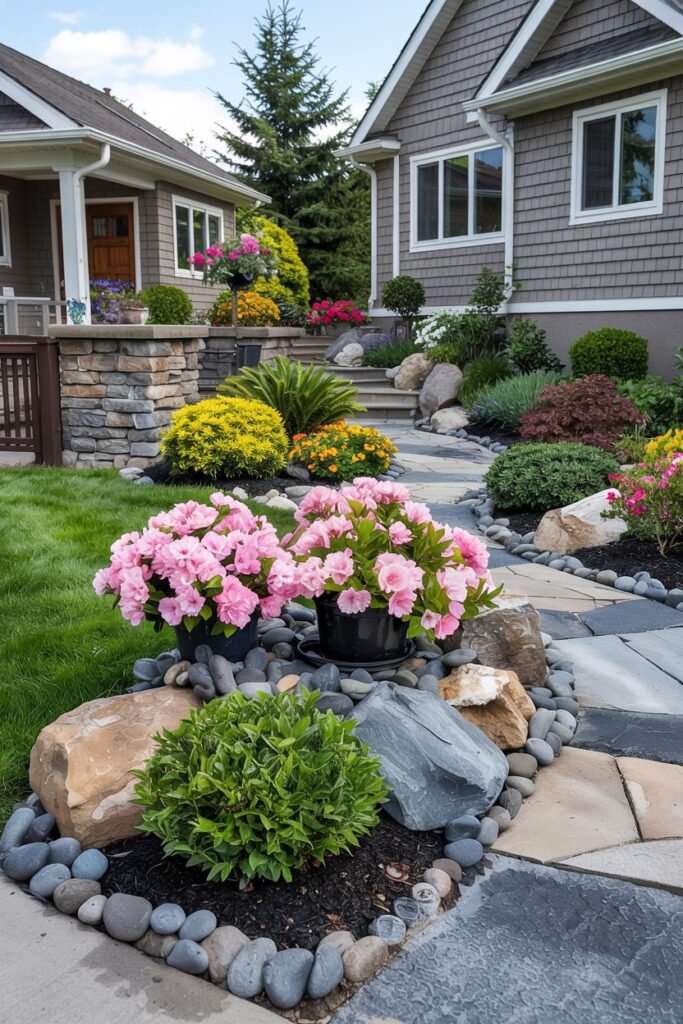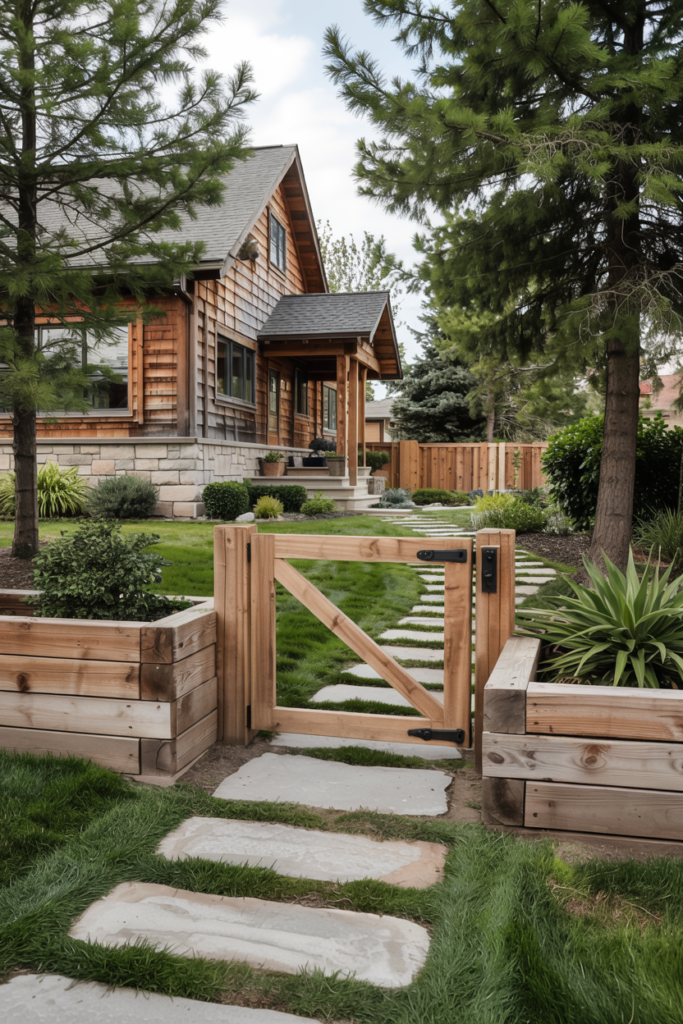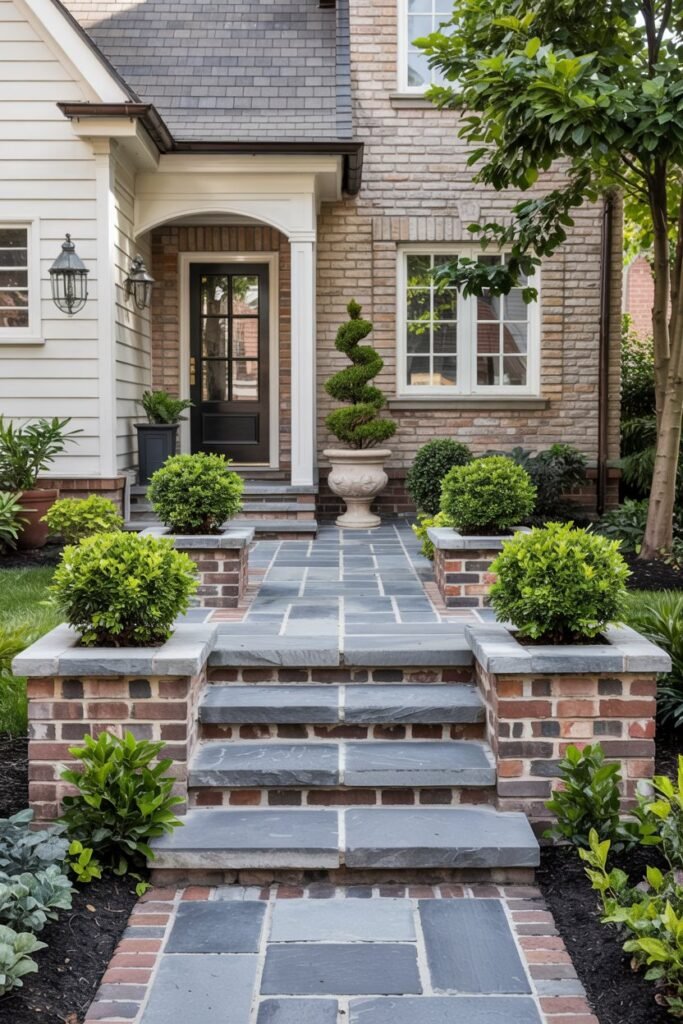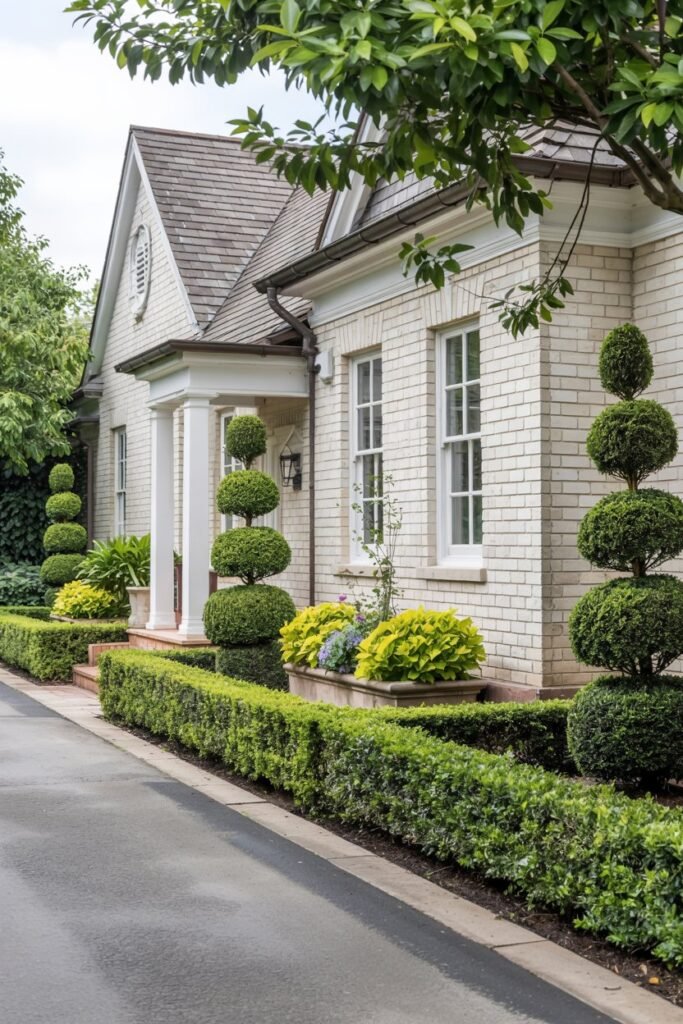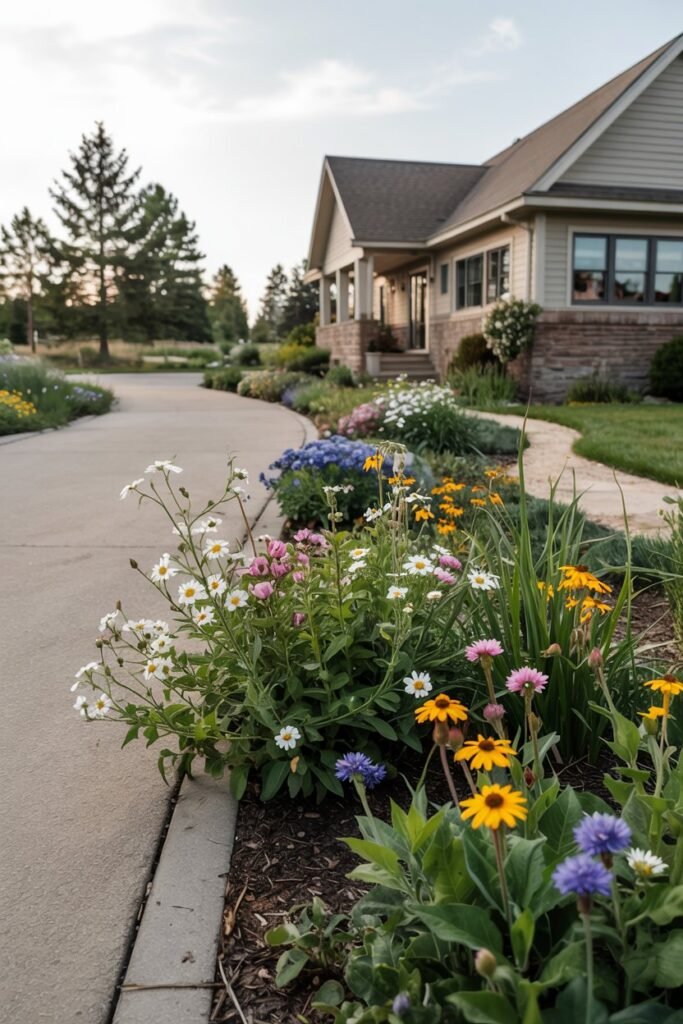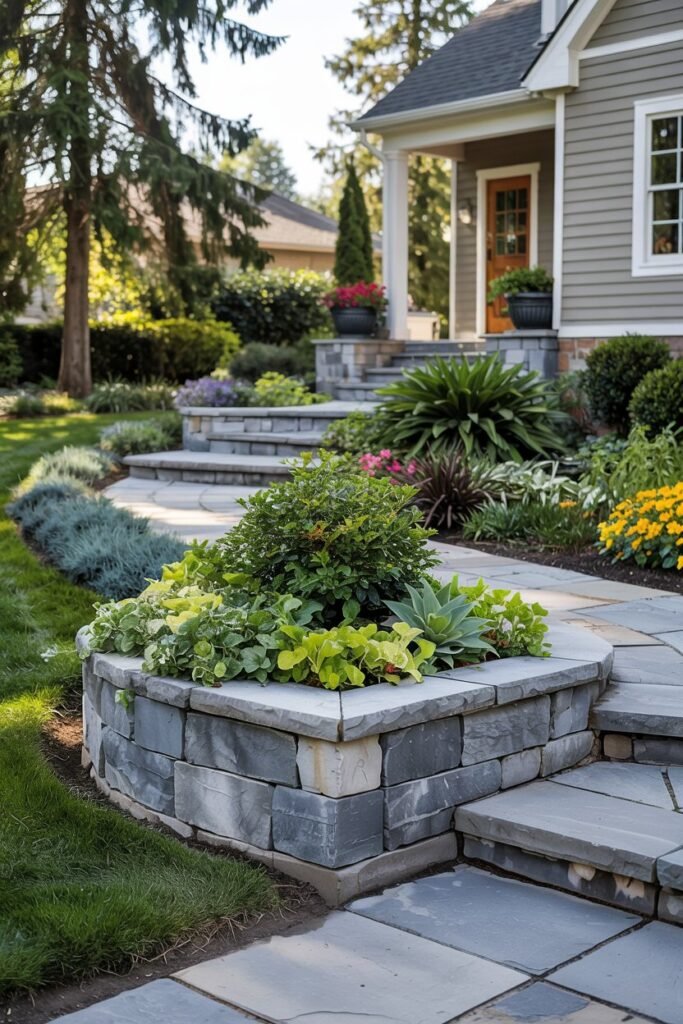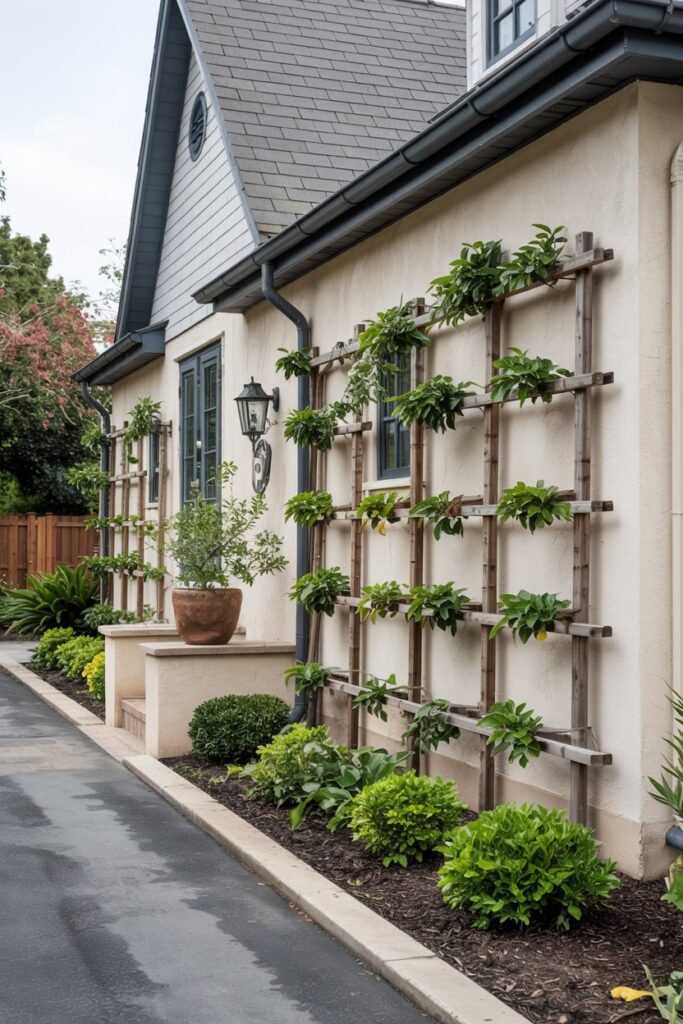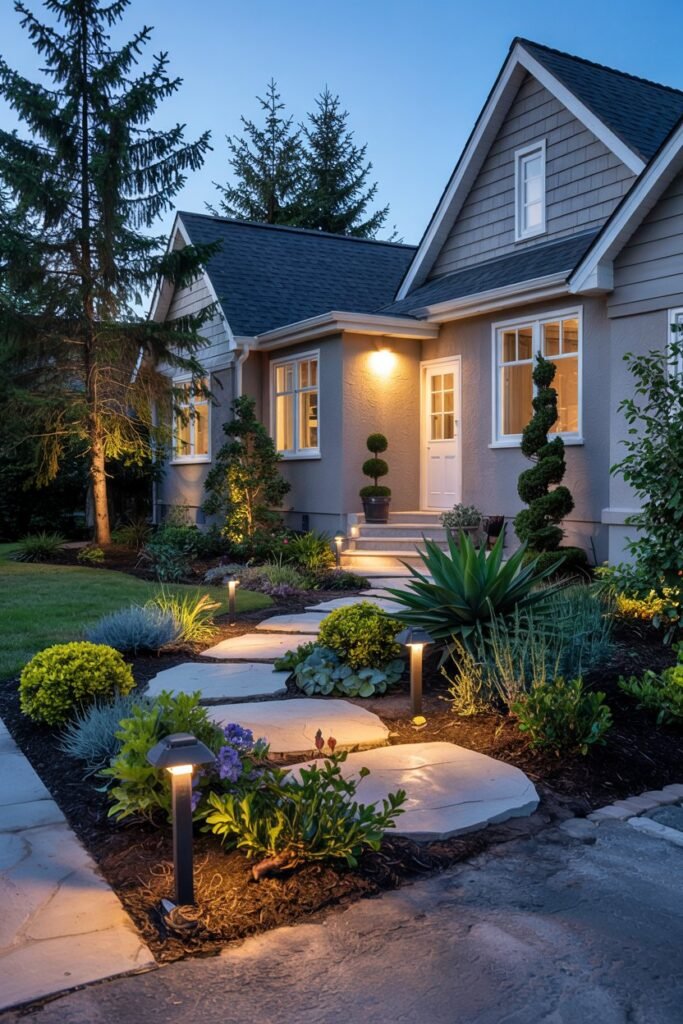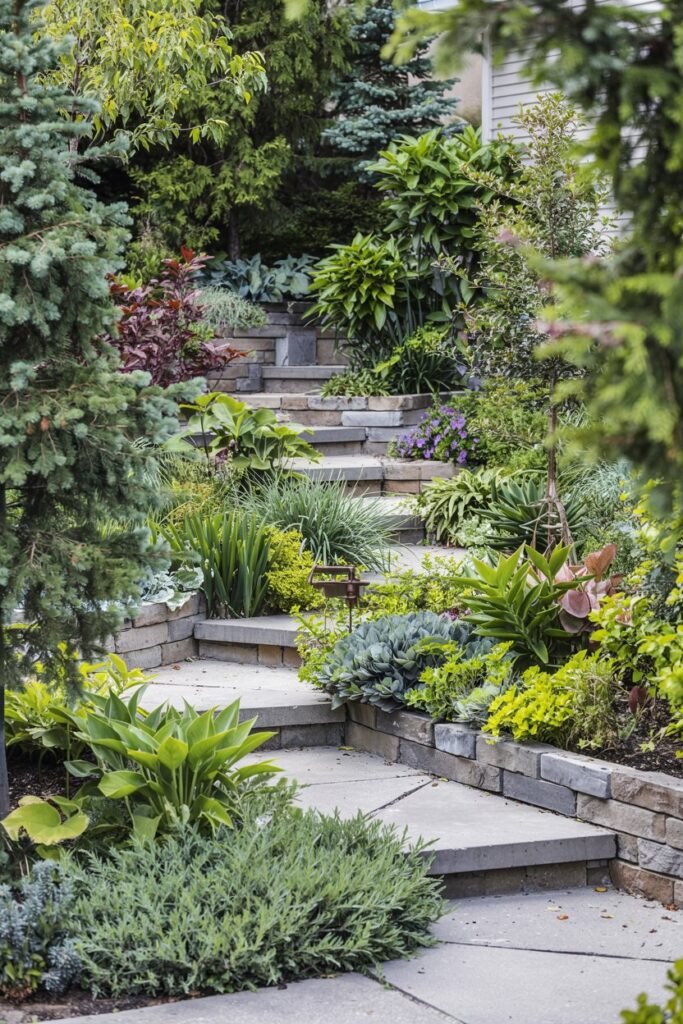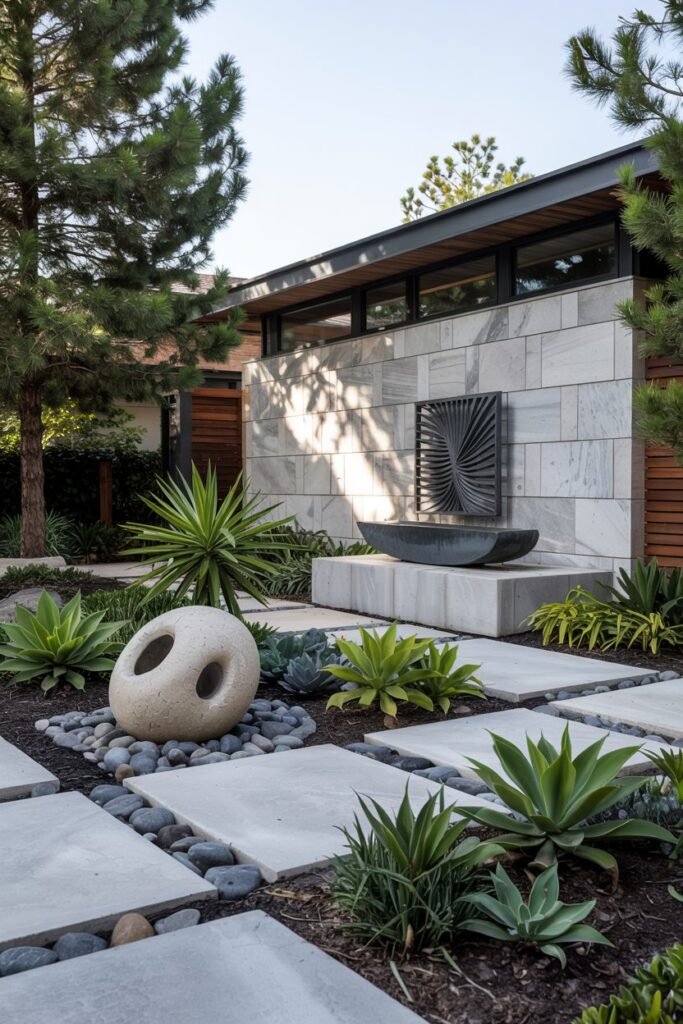20 Front Driveway Garden Ideas to Transform Your Home’s Curb Appeal
Your driveway doesn’t have to be just a path for your car. I’ve discovered that the space alongside it offers incredible potential to boost your home’s curb appeal and create a welcoming entrance. Whether you’re working with a long stretch of asphalt or a compact gravel pathway, the right landscaping can turn this functional space into something beautiful.
I’ve gathered 20 inspiring front driveway garden ideas that range from low-maintenance solutions to bold design statements. Each approach offers its own benefits, and I’ll walk you through what makes them work so you can find the perfect fit for your home.
1. Garden Meets Gravel Driveway
I love how vibrant greenery softens the rough texture of a gravel driveway. This approach brings together the practical elements of a rocky surface with the natural beauty of simple green plants.
The midcentury modern aesthetic works particularly well here. I find that choosing low-maintenance plants prevents oversaturation while keeping the space looking intentional. The orderly patterns created by strategic plant placement complement your home’s architecture without overwhelming it.
This design works best when you select plants that can handle the conditions near gravel—they need to tolerate occasional stone migration and the heat reflection from the driveway surface.
2. Geometric Pavers
I’ve seen how meandering geometric pavers can visually lengthen a driveway space and create genuine visual interest. The combination of concrete pavers with strategically placed trees offers a modern, innovative look that feels fresh.
This approach balances beautifully with architectural elements. I appreciate how the pavers create a natural focal point that draws the eye along the driveway’s length. The geometric patterns add structure while the trees provide organic softness.
When I implement this design, I make sure the paver pattern complements rather than competes with the home’s existing lines and angles.
3. Low Maintenance Ornamental Grasses
I find ornamental grasses to be one of the most rewarding driveway plantings. Simple lines of these grasses add graceful movement while requiring minimal upkeep—just one trim per year.
The modern, minimalist aesthetic suits contemporary homes perfectly. I often pair ornamental grasses with dwarf maples to create height variation and seasonal interest. The grasses sway with the breeze, bringing life to what might otherwise be a static space.
This option works exceptionally well if you want maximum visual impact with minimum maintenance time. I recommend choosing varieties suited to your climate zone for best results.
4. Shrubs Paired With Flowers
I combine flowers and shrubs to create a varied, natural look along driveways. Evergreen yew shrubs provide year-round structure while flowering plants like lavender add seasonal color and fragrance.
This informal design style softens the hard edges of a driveway beautifully. I’ve found that this combination is particularly effective at discouraging browsing deer in areas where they’re common. The mix of textures—from the dense shrubs to the delicate lavender blooms—creates visual depth.
The lavender also releases its signature scent when brushed against, adding a sensory dimension to your driveway experience.
5. Designs on the Driveway
I decorate driveways themselves using colorful bricks to create patterns and visual interest. This approach breaks up large expanses of monotonous paving and adds a custom, decorative touch.
The patterns can range from simple borders to intricate designs that reflect your personal style. I find this particularly effective for longer driveways where the surface itself becomes part of the landscape design rather than just a functional element.
When I plan these designs, I consider how the patterns will look from different angles—from the street, from the house, and from your car as you drive in.
6. Planter Box
I use neat planter boxes to define the space between lawn and driveway. This approach provides clear boundaries and works exceptionally well in smaller spaces where every inch counts.
The defined, neat aesthetic keeps everything organized and intentional. I appreciate how planter boxes allow you to control soil quality and drainage independently from the surrounding ground. This makes it easier to grow plants that might not otherwise thrive in your yard’s natural conditions.
The raised design also adds vertical interest and can help protect plants from being accidentally driven over.
7. Rocks and Flowering Bushes
I create vibrant, textured landscapes by combining flowering bushes with decorative rocks. The bountiful blooms deliver punchy color while the rocks provide structure and contrast.
This design adds dimension to driveway gates and entrance areas. I select flowering bushes that bloom at different times to extend the color season. The rocks serve a practical purpose too—they reduce maintenance by suppressing weeds and retaining moisture.
When I implement this design, I vary the rock sizes to create a more natural appearance and prevent the space from looking too uniform.
8. Wooden Gate
I use untreated wood retaining walls or fences to warm up the cooler tones typically found in driveway materials. The rustic aesthetic creates welcoming curb appeal that feels both natural and intentional.
Wood juxtaposes beautifully against green grass and creates visual interest through texture contrast. I’ve found that allowing wood to weather naturally enhances this effect over time, developing a silvery patina that many homeowners love.
This approach works particularly well with homes that have natural or traditional architectural styles.
9. Minimalist Cacti
I incorporate cacti to add curb appeal through their unique colors and shapes while maintaining a minimalist aesthetic. These plants take up less space than traditional landscaping options, making them perfect for narrow driveway borders.
The sculptural quality of cacti creates architectural interest without requiring extensive maintenance or water. I find this approach particularly effective in arid climates where water conservation is important. The variety of cacti shapes—from tall columnar varieties to low rounded forms—allows for creative compositions.
This design proves that less can truly be more when you choose plants with strong visual presence.
10. Brick All the Way
I use planters filled with bushes and ground cover to counterbalance stone driveways. This stylish, balanced approach offers minimal maintenance with maximum visual appeal.
The contrast between structured brick or stone surfaces and the organic forms of plants creates a sophisticated look. I appreciate how this design frames the driveway without overwhelming it. The ground cover in the planters softens edges while the bushes provide height and privacy.
This configuration works especially well for formal homes where a neat, orderly appearance is important.
11. English-Style Front Yard Garden
I recreate the charm of an English cottage garden along driveways using a pleasing mix of annuals, perennials, and hydrangeas. This design captures a romantic, established feeling even in new landscapes.
I organize plants along a decorative white picket fence that runs parallel to the driveway. The blooms create a tapestry of pink, blue, purple, and yellow that changes throughout the seasons. This layered approach means something is always blooming, providing continuous visual interest.
The informal arrangement looks natural rather than contrived, as if the garden has been there for years.
12. Formal Hedge Border
I plant formal hedges along driveways to create clean lines and a sense of estate-style elegance. This classic approach never goes out of style and works with virtually any architectural period.
Boxwood or privet hedges require regular trimming to maintain their shape, but I find the crisp appearance worth the effort. The uniform green provides a sophisticated backdrop for seasonal color if you choose to add flowering plants in front.
This design particularly suits colonial, Georgian, or French-style homes where symmetry and formality are architectural priorities.
13. Wildflower Meadow Strip
I establish wildflower meadow strips along driveway edges for a naturalistic, low-maintenance approach. This design attracts pollinators while reducing the need for mowing and intensive care.
I select native wildflower mixes that bloom sequentially throughout the growing season. The changing colors and textures create a dynamic landscape that never looks the same twice. This approach also supports local ecosystems and provides habitat for beneficial insects.
The informal, prairie-like appearance works beautifully with ranch-style homes and properties with a more casual aesthetic.
14. Raised Stone Planters
I build raised stone planters at intervals along driveways to add vertical interest and create natural stopping points for the eye. The elevated design showcases plants more effectively than ground-level planting.
These planters work particularly well on sloped driveways where they can also serve a functional purpose in managing grade changes. I fill them with a mix of trailing plants that cascade over the edges and upright varieties that add height.
The stone construction ensures durability and blends seamlessly with most architectural styles.
15. Seasonal Container Gardens
I place large containers along driveways that I can replant seasonally for ever-changing displays. This flexible approach lets me experiment with different color schemes and plant combinations without permanent commitment.
The containers themselves become decorative elements—I choose styles that complement the home’s architecture. This design works exceptionally well for renters or those who enjoy frequently refreshing their landscape. I can swap out tired summer annuals for vibrant fall mums, then transition to evergreen arrangements for winter interest.
The mobility also allows me to rearrange elements as needed for events or seasonal celebrations.
16. Espaliered Fruit Trees
I train fruit trees flat against walls or fences along driveways using the espalier technique. This space-saving approach produces edible crops while creating living artwork.
The structured, geometric forms of espaliered trees suit formal landscapes beautifully. I find this particularly useful along narrow driveway borders where traditional trees would overhang or create clearance issues. The process requires patience and regular pruning, but the results are stunning and productive.
This design combines ornamental beauty with practical harvest, making it especially appealing for homeowners interested in edible landscaping.
17. Lighting-Integrated Landscape
I incorporate low-voltage lighting into driveway landscaping to enhance safety and extend visual appeal into evening hours. Strategic uplighting showcases specimen plants while path lights ensure safe navigation.
The combination of illumination and thoughtfully chosen plants creates dramatic shadows and highlights texture. I select fixtures that complement the landscape design rather than distract from it. Solar options reduce installation complexity and eliminate ongoing electrical costs.
This approach transforms your driveway landscape into a 24-hour design feature rather than something that disappears after sunset.
18. Succulent Border Garden
I create water-wise succulent borders along driveways for stunning visual impact with minimal irrigation needs. The variety of colors—from blue-green to deep purple—and textures available in succulents allows for creative compositions.
These plants thrive in the typically harsh conditions near paved surfaces where heat reflection and drainage are concerns. I arrange them in repeating patterns or natural-looking clusters depending on the desired aesthetic. Many succulents also produce colorful blooms that add seasonal interest.
This design proves especially practical in drought-prone regions or for homeowners seeking to reduce water consumption.
19. Layered Mixed Planting
I design layered plantings with varying heights along driveways—tall trees in back, medium shrubs in the middle, and low perennials or ground covers in front. This creates depth and visual interest from multiple viewing angles.
The layered approach mimics natural plant communities and creates a mature appearance more quickly than single-height plantings. I select plants with complementary bloom times and foliage colors to ensure year-round appeal. This design also provides better privacy screening and noise reduction than sparse, single-layer plantings.
The complexity of textures and forms makes even narrow planting strips feel lush and abundant.
20. Modern Sculptural Elements
I integrate modern sculptural elements—like decorative panels, artistic boulders, or contemporary plant containers—with minimalist planting schemes along driveways. This approach emphasizes form and negative space rather than abundant plantings.
The sculptural elements serve as focal points that anchor the design. I choose plants with strong architectural qualities like agaves or ornamental grasses to complement rather than compete with the art pieces. This design particularly suits contemporary and ultra-modern homes where clean lines and artistic expression are priorities.
The restrained plant palette keeps maintenance minimal while delivering maximum visual impact.
Conclusion
Transform your driveway from a purely functional space into a landscape feature that welcomes you home and impresses your visitors.
Start by assessing your space, climate, and maintenance preferences, then choose the approach that resonates with your style.
Remember that even small changes can make a significant difference in your home’s curb appeal. Pick one idea that speaks to you and begin creating the driveway landscape you’ve been envisioning.

